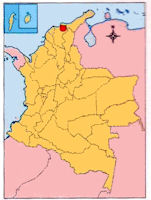Early Colombia - Tairona
 The Lost City, or Ciudad Perdida, is more than just the destination for a gruelling five-day hike through the jungle near Santa Marta, which concludes with the ascent of some 1,200 stone steps to reach the city itself. For the nearby Kogi, Arhuaco and Wiwa peoples, this is a sacred place that was once the political and manufacturing center for their ancestors, the Tairona. The hike itself passes several indigenous villages and recreations as to how the Tairona lived.
The Lost City, or Ciudad Perdida, is more than just the destination for a gruelling five-day hike through the jungle near Santa Marta, which concludes with the ascent of some 1,200 stone steps to reach the city itself. For the nearby Kogi, Arhuaco and Wiwa peoples, this is a sacred place that was once the political and manufacturing center for their ancestors, the Tairona. The hike itself passes several indigenous villages and recreations as to how the Tairona lived.
The Lost City is hidden deep in Colombia’s jungle and consists of around 170 stone terraces carved into a mountain, with numerous small “plazas” and connecting “streets”. These are the remains of a city built in around 800AD, some 650 years before Peru’s Machu Picchu. The mountain in question is part of the Sierra Nevada de Santa Marta range, which is just 42km (26 miles) from Colombia’s Caribbean coast. With peaks reaching 5,700m (18,700ft) it’s the world’s highest coastal mountain range.
Ciudad Perdida was re-discovered in 1972 when treasure hunters found the steps leading to the city, then covered in jungle, and named it the “green hell”. Treasures from the site, including gold figures and ceramics, soon began to appear on the black market and that alerted archaeologists. They reached the city in 1976 and began a careful excavation and restoration that was completed six years later. But local indigenous people, including the Koguis, Wiwas and Arhuaco who are all descendants of the Tairona, say they had always known the city’s location and had visited it, but preferred to keep it secret.
The Tairona were an important group of the Chibcha family. Investigartors have been discovered archaeological sites very important in this culture as the famous Lost City, where there are great works like rings ciedra, roads, staircases, terraces and canals, among others. The geographical location of the Tairona was in the Sierra Nevada de Santa Marta, but the date on which they began peopling it is still not known. It is estimated that Lost City was built around the 300 year 300 AD.
Tairona society was organized in villages, each one of which had a ruler. A set of villages formed a confederation. The confederations were Bonda and Pocigueica. It is considered that the Tairona population must have been very numerous and always subject to very strict rules - an iron discipline - because it was necessary a great amount of manpower to carry out driveways, roads, bridges, canals, agricultural terraces, pools, homes and temples. Tairona figures elaborated in gold, depict a man with a headdress shaped with bats.
The main authorities of the community were caciques who had civil powers in Bonda and Pocigueica. Each cacique dictated social, military and religious norms for the community. They led war against other peoples and were considered a god. In turn, the chief should ensure that his people were safe from attacks by other neighbors and showing the have good harvests for the people did not go hungry. The main economic activity was agriculture, especially the cultivation of maize, beans, cassava, yams, squash, chili, cotton and some fruits. They also practiced fishing, breeding birds and trading with other indigenous communities. For example, they traded emeralds and blankets for fish, shells and sea snails wtih highland Indians.
Tairona religion was based on the cult of natural phenomena . They worshiped the sun, moon and stars. The priests were responsible for establishing communication between the people and the gods and directed the rites performed and ceremonies in which the fertility of the land held or grateful for good harvests. Burials and life in the "beyond" were not issues for Taironas to worry much. His interest was focused more earthly life. This can be inferred by the high number of works, which contrasts with the small number of burials.
Tairona culture was especially distinguished for its architecture in stone. Temples, like housing, were built with a stone base of circular walls and ceilings were made with wooden logs coated with vegetable fibers and bahareque. They had advanced road system and stairs that connected the various populations and served as walls to prevent erosion and floods. The rings of stone and walls were containment in the areas of culture, They were intended to prevent landslides and care for nature.
The tairona was the only community in Colombia that made buildings with stone. The Tairona community developed ceramics and metalwork where they accounted zoomorphic and anthropomorphic figures, many details, giving samples of advanced knowledge technical for processing. The Tairona culture was one of the most advanced in the country.
|
NEWSLETTER
|
| Join the GlobalSecurity.org mailing list |
|
|
|

